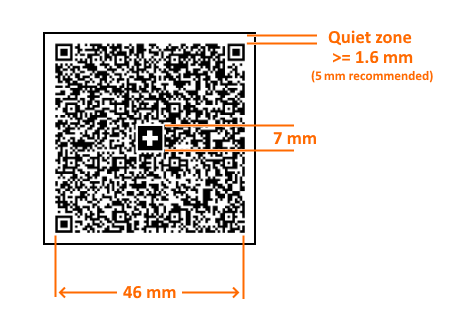Configuring the Swiss QR Code in Reports
The Swiss QR Barcode is used mostly in the QR-bill, which is a document designed to replace the payment slips and currently used in payment transactions in Switzerland.
The Swiss QR Barcode uses the QR symbology to encode its data, applying a few rules on the encoding parameters and physical (printed) dimensions. For a runnable example, refer to the Swiss QR Bill Report demo.
Structure
The following image shows the structure of the Swiss QR Barcode.

The most important characteristics of the Swiss QR Barcode are:
To ensure that the Swiss QR Code is read securely, a minimum module size of 0.4 mm is required when printing. Converted to pixels on 96 DPI that makes ~1.51px. Due to rounding to a whole pixel, when the barcode is previewed on a computer screen, it may seem that some modules have a different size from the others. This effect gets resolved when rendering in a format that uses anti-aliasing and is not observed when printing, due to the printer higher DPI.
The measurements of the Swiss QR Code for printing must always be 46 x 46 mm without the surrounding quiet space. To satisfy this requirement, the barcode item will calculate the minimum size of the Barcode item on the design surface and will display an error message if the item size is not large enough. Forcing a constant barcode size also makes the
Stretchproperty redundant, so it is not respected.-
The quiet zone or area is the space surrounding the barcode modules. The QR barcode specification mandates that the quiet zone at least four modules wide, which equals to 1.6 mm given the minimum module size.
The Swiss QR Code design specifications suggests the quiet zone to be set to 5 mm. To satisfy this requirement the
SwissQRCodeEncoderprovides a dedicated property namedQuietZonethat allows you to set the width of the quiet zone in a string format, for example,5mm,0.5cm, or0.2in. To increase the recognizability, the Swiss QR Code contains an additional recognition symbol: a Swiss cross logo measuring 7 x 7 mm. The logo is rendered in the center of the barcode, overlaying the existing barcode modules.
Settings
Since the Swiss QR barcode is an extension of the QR barcode symbology, some of the settings applicable to QR barcode are also applicable to the Swiss QR barcode.
Bill Data
The BillData compound property contains the data needed to construct the correctly formatted barcode value. The property consists of the Creditor, Debtor, and Payment sub-properties, each containing relevant information about the bill data.
Creditor
The Creditor property contains information about the Payable To data entity.
-
Address—Determines the Creditor address fields, shown below in alphabetical order:
- (Mandatory) City—35 characters max
- (Mandatory) Country—Contains the two-letter country code as defined by ISO 3166-1
- (Optional) House Number
- (Mandatory) Postal code—16 characters max
- (Optional) Street
(Mandatory) IBAN—Must pass the validation check for an IBAN identifier.
- (Mandatory) IBANType—Determines the type of the IBAN field. The supported values are
IBANandQRIBAN. The default value isIBAN. - (Mandatory) Name—Determines the Creditor name, 70 characters max.
Debtor
The Debtor property contains information about the Payable By data entity.
- Address—Determines the Debtor address fields, following the same rules as the Creditor address fields, listed above.
- (Mandatory) Name—Determines the Debtor name, 70 characters max.
Payment
The Payment property contains information about the Payment data entity.
- (Optional) AdditionalInfo—Contains additional information about the bill recipient.
- (Optional) AlternativeProcedure1—Represents the first of the two elements containing specific information about the alternative procedures applied to the bill.
- (Optional) AlternativeProcedure2—Represents the second of the two elements containing specific information about the alternative procedures applied to the bill.
- (Mandatory) Amount—Contains the amount of money to be paid. Maximum 12 digits, including the decimals. The default value is
0.01. - (Mandatory) Currency—Determines the amount currency. The supported values are
CHF,EUR. The default value isCHF. -
Reference—Determines the payment reference number. It can be empty or
nullwhen the ReferenceType field is set toNON. The length is [5 - 25] characters. - (Mandatory) ReferenceType—Determines the type of the payment reference number. The supported values are
NON,SCOR,QRR. The default value isNON. - (Optional) StructuredBillInfo—Contains coded information for automated booking of the payment. 140 characters max.
Quiet Zone
QuietZone determines the size of the quiet zone (quiet area). Represents the unprinted border around the barcode modules. It can be set in physical units like 1.6mm or 0.5cm. The size of the quiet zone is taken into account when calculating the required size of the Barcode item.
Validate the Bill Data
ValidateBillData determines whether the data provided in the BillData property will be validated or not. If set to false, the data will not be validated. If set to true, the data will be validated under the following conditions:
- At design-time the validation will be performed only if the
BillDataproperty contains static values, that is, its fields must not contain any expression. - At run-time (during the report processing stage) the validation will be always performed, because all the expressions will be evaluated against the current data context.
Value from Bill Data
ValueFromBillData determines whether the Value property of the barcode will obtain its value from the data configured in the BillData property or not. If set to true, the data will be constructed from the fields in the BillData property. If set to false, the BillData fields will not be respected and the barcode item will encode the raw data used in the Value field.